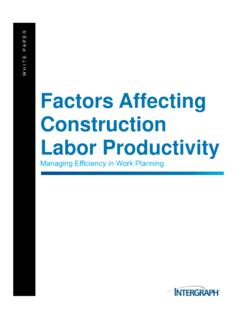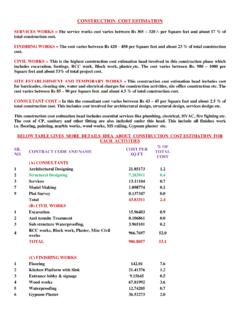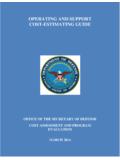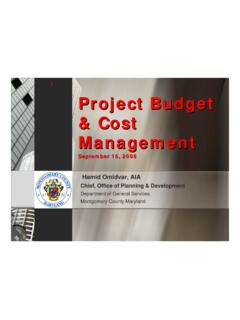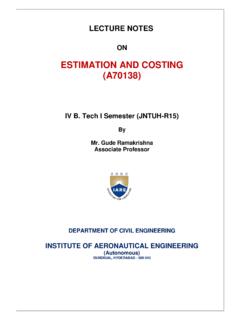Transcription of Cost estimation for coastal protection – summary of evidence
1 cost estimation for coastal protection summary of evidence Report SC080039/R7 ii cost estimation for coastal protection summary of evidence We are the Environment Agency. We protect and improve the environment and make it a better place for people and wildlife. We operate at the place where environmental change has its greatest impact on people s lives. We reduce the risks to people and properties from flooding; make sure there is enough water for people and wildlife; protect and improve air, land and water quality and apply the environmental standards within which industry can operate. Acting to reduce climate change and helping people and wildlife adapt to its consequences are at the heart of all that we do. We cannot do this alone. We work closely with a wide range of partners including government, business, local authorities, other agencies, civil society groups and the communities we serve.
2 This report is the result of research commissioned by the Environment Agency s evidence Directorate and funded by the joint Flood and coastal Erosion Risk Management Research and Development Programme. Published by: Environment Agency, Horizon House, Deanery Road, Bristol, BS1 5AH Environment Agency March 2015 All rights reserved. This document may be reproduced with prior permission of the Environment Agency. The views and statements expressed in this report are those of the author alone. The views or statements expressed in this publication do not necessarily represent the views of the Environment Agency and the Environment Agency cannot accept any responsibility for such views or statements. Email: Further copies of this report are available from our publications catalogue: or our National Customer Contact Centre: T: 03708 506506 Email: Author(s): Thomas Hudson, JBA Consulting Kevin Keating, JBA Consulting Angus Pettit, JBA Consulting Dissemination Status: Publicly available Keywords: Whole life costing, cost estimation , coastal erosion, coastal protection Research Contractor: JBA Consulting South Barn, Broughton Hall, Skipton North Yorkshire BD23 3AE 01756 799919 Environment Agency s Project Manager: Adam Baylis, evidence Directorate Collaborator(s): John Chatterton Alan Williams Project Number.
3 SC080039/R7 cost estimation for coastal protection summary of evidence iii evidence at the Environment Agency evidence underpins the work of the Environment Agency. It provides an up-to-date understanding of the world about us, helps us to develop tools and techniques to monitor and manage our environment as efficiently and effectively as possible. It also helps us to understand how the environment is changing and to identify what the future pressures may be. The work of the Environment Agency s evidence Directorate is a key ingredient in the partnership between research, guidance and operations that enables the Environment Agency to protect and restore our environment. This report was produced by the Scientific and evidence Services team within evidence . The team focuses on four main areas of activity: Setting the agenda, by providing the evidence for decisions; Maintaining scientific credibility, by ensuring that our programmes and projects are fit for purpose and executed according to international standards; Carrying out research, either by contracting it out to research organisations and consultancies or by doing it ourselves; Delivering information, advice, tools and techniques, by making appropriate products available.
4 Miranda Kavanagh Director of evidence iv cost estimation for coastal protection summary of evidence Executive summary This summary of evidence provides indicative costs and guidance for coastal erosion and flood management activities. coastal environments are often very dynamic and are highly variable in terms of the severity of exposure to natural conditions. Producing collated cost information is therefore challenging. coastal Key cost components Key cost components are likely to be the enabling costs (procurement, planning and design), capital construction costs and post construction monitoring and maintenance costs. Key asset types Walls Revetments/ coastal embankments Groynes Beach recycling and recharging or nourishment Dune, shingle, beach management Managed realignment discussed separately (see below) Data reviewed in specific guidance Key datasets include: Environment Agency Unit cost Database (capital costs).
5 Various other case studies and examples Other relevant data Local or proxy records such as data from Environment Agency SAMPs and local authority information Relative cost importance Enabling costs Costs may be higher than other measures due to the level of consultation, design and preliminary assessments required. Capital costs Variable costs depending on type of assets and management methods, asset length and size, associated structures and site conditions, but typically much higher than the fluvial equivalent. Dune, shingle and beach management are more likely to have significantly lower costs, but often higher maintenance costs. Maintenance costs Variable. Walls may offer a very low maintenance burden, but revetments and particularly beach recycling/nourishment schemes can have high ongoing costs.
6 Other cost considerations May include environmental costs, habitat creation and decommissioning costs. cost estimation for coastal protection summary of evidence v cost estimation methodology Initial concept/national appraisal Approximate unit rates for the completed asset available Strategic, regional, or conceptual design Approximate unit rates for the completed asset available. Costs for some asset types not available and specialist advice likely to be required. Preliminary feasibility/design No specific cost information provided. Guidance on data availability and procedures provided. Design life information Data provided by Environment Agency asset deterioration reports are provided for guidance associated with embankment design lives. Some additional design life references are also provided.
7 Quality of data Coordinated, readily available information is relatively absent for coastal erosion and protection measures, although some example unit costs are available for a number of different asset types. Coordinated recording of actual out-turn costs for these assets is limited, but some case studies and very generic costs from literature are provided to assist appraisers on the scale of costs for broad scale, early cost estimates. The scale of information is fairly broad and useful only for very high level strategic, national or very early stage cost assessments. Insufficient information is available to derive cost curve data to support tool development. Available information and guidance on the key aspects is provided to support practitioners undertaking high level costs estimates.
8 Additional guidance Checklist of factors likely to influence capital and maintenance costs, and key factors to consider for detailed costs estimation List of R&D and general design guidance Case studies of recent schemes vi cost estimation for coastal protection summary of evidence Acknowledgements The authors wish to thank the Project Board (Ian Meadowcroft, Linsay Hensman and Adam Baylis) and the Environment Agency, local authority and Internal Drainage Board representatives and operational staff who were consulted. cost estimation for coastal protection summary of evidence vii Contents 1 Long term costing - coastal flood protection 1 Forms of coastal defence operations 1 Key cost requirements 4 Enabling costs 5 Generic capital cost ranges 9 Capital costs 11 Operation and maintenance costs 19 coastal monitoring 23 Design life and asset deterioration 28 cost estimation methodology 30 Case studies 31 Checklist 34 R&D and general design guidance 35 References 36 Table Typical elements of the cost of beach control works (CIRIA 2010)
9 5 Table Indicative costs associated with the cost of coastal protection 10 Table Key cost considerations for coastal works 11 Table Example costs from the Environment Agency Unit cost Database associated with beach recycling/recharge 13 Table Example costs from the Environment Agency Unit cost Database associated with coastal walls 14 Table Example costs from the Environment Agency Unit cost Database associated with revetments 15 Table Example costs from the Environment Agency Unit cost Database associated with rock groynes 18 Table Estimated groyne construction costs ( /m) 19 Table Environment Agency suggested maintenance frequencies 20 Table summary of potential monitoring data requirements 24 Table Deterioration rates for different materials in coastal environments 28 Table Deterioration rates for revetments in coastal environments 29 Figure Flow diagram for coastal whole life costs 30 Figure Erosion of Environment Agency flood defence embankment, November 2004 (source: Terry Oakes Associates Limited) 31 Figure Completed East Lane, Bawdsey Coast protection and Flood Defence Scheme (source: M Page) 32 Figure coastal erosion, 1962 (image courtesy of Environment Agency) 33 Figure Completed seawall, beach and jetties (image courtesy of Environment Agency) 33 Figure Alkborough Flats managed realignment breach to the right (copyright.)
10 Environment Agency) 33 1 Long term costing - coastal flood protection coastal management in the UK has evolved significantly in design and execution over the last 20 30 years from building structures to reduce shoreline erosion and prevent flooding of the hinterland to working with tidal and wave processes. A coastal protection system consists of a combination of the beach and backshore elements such as cliffs, beaches, dunes and/or artificial defences that contribute to flood protection and coastal erosion prevention. Forms of coastal defence operations There are a number of forms of coastal defences from natural beach and dune defences from structural flood defence walls and revetments that limit tidal overtopping, through to breakwaters and groynes designed to reduce longshore sediment transport and reduce wave heights.










